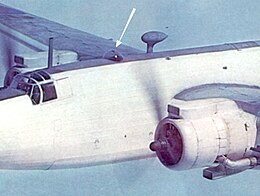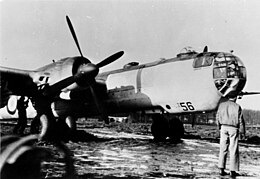38:
123:(RAF) became seriously interested in the widespread use of astronavigation for nighttime flights. During November 1937, astronavigation was formally endorsed to be a part of standard navigation procedure amongst general reconnaissance and twin-engine bomber pilots. Two years later, a specialised bubble sextant was designed for the service, which became a preferred tool for this form of navigation. Typically, there would be a suspension arm mounted in the vicinity of the astrodome, upon which the sextant could be mounted via a swivel clip affixed to the top of the instrument.
27:
99:, astronavigation became a critical ability used to by various nations to conduct long distance flights at night, particularly strategic bombing campaigns. The RAF's choice to mainly operate its bombers at night meant that its crews were particularly dependent on astronavigation for finding their way to and from targets. The introduction of
92:(RAF) adopted astronavigation techniques into standard navigator training during the late 1930s, both the methods used and the design of the sextant were adapted to better suit the aviation environment, while many aircraft ordered by the service would be furnished with astrodomes to enable navigators to use this technique.
190:
were becoming increasingly available; these devices would eventually displace the use of astronavigation and thus aircraft would increasingly be built without astrodomes or other accommodations for this means of navigation. Astrodomes added drag and could fail under pressurization (called a blowout)
150:
four-engined heavy bomber, the astrodome was angled so that it could provide generous external views, including of ground positions, not only those relevant to the task of astronavigation, thus the facility was sometimes used for observation (unrelated to navigation). Several
284:
flying boat. Not only could he use it for sextant astro-navigation, but it provided a sheltered place from which he could steer his yacht during a stormy race. This was quite useful, as his wind-vane autopilot (also derived from aeronautical technology) had broken down.
142:. Furthermore, numerous aircraft would be retrofitted with astrodomes to better facilitate operational use. For the RAF, it was particularly important for specific aircraft to possess astrodomes as the service had opted to perform the majority of its
181:
Several RAF bombers, such as the
Sterling, were equipped with an astrograph; this device, installed above the navigator's table, projected lines of equal altitude for two stars at any one time. The navigator only needed to observe
119:. During these early days of aviation, those individual officers that chose to employ astronavigation often attempted to simplify the traditional procedures of marine navigators in this new operating context. Amid the 1930s, the
265:
era, the use of the astrodome spread to other vehicles, including a number of ocean-going vessels. In particular, they found popularity on long distance racing yachts, especially those that were being used in solo racing.
206:, while furnished with internal navigation systems, would often still be navigable by astronavigation. During the early 1960s, astrodomes were still being employed in the USMC Lockheed Hercules GV-1 (later designated as
245:, which could see stars during both day and night, would continuously track a variety of stars as the aircraft's changing position brought them into view. The system's digital computer
475:
191:
which has occurred in several instances often with fatal consequences for the navigator. Efforts were made to reduce this danger such as retractable periscopic sextants.
241:. This system performed its observations of the stars above the aircraft via a circular quartz glass window set onto the upper fuselage. Its "blue light" source
365:
348:
211:
178:. On the B-29, the bonding of the astrodome was designed so that it would generate only minimal radio interference via static electric discharges.
158:
Similar hemispherical-shaped domes were also installed on some Second World War era heavy bombers for the purpose of sighting of their defensive
250:
37:
115:
Sporadic use of astronavigation in aviation can be found in numerous long distance flights performed during the 1920s and even amid the
318:
554:
608:
273:
215:
479:
640:
146:
over the continent under the cover of night, hindering conventional navigation by landmarks. On numerous aircraft, such as the
635:
501:
210:); the navigator was able to employ a bubble sextant hung from a hook in the middle of the dome. The USMC operated its
68:
Astronavigation was a principal early method for attaining an aircraft's position during nighttime by referencing the
630:
526:
294:
234:
540:
276:, and former French Aéronavale (Fleet air arm) pilot, had fitted his revolutionary lightweight ketch-rigged racer
199:
175:
171:
222:
187:
625:
230:
131:
460:
226:
186:
from this point to achieve a three-star fix. While deemed to be useful in astronavigation, by this time
54:
238:
62:
42:
162:, particularly those that were remotely operated. Examples of such installations include the German
134:-operated multi-engined aircraft and on foreign aircraft ordered by them for their use, such as the
438:
391:
107:
soon competed with astronavigation, although electronic techniques had their shortcomings as well.
412:
80:, and proved to be applicable to faster moving aircraft as well, however, the task required a 360-
600:
167:
143:
604:
281:
127:
100:
96:
387:
434:
120:
116:
89:
31:
65:
and thereby guide the aircraft at night without the aid of land-based visual references.
195:
163:
152:
147:
135:
81:
229:
aircraft, was furnished with a complex array of navigation systems, which included an
619:
139:
166:
A, which had a single forward dorsal dome to aim its remotely operated FDL 131 twin
26:
388:"AMERICAN AIRCRAFT IN ROYAL AIR FORCE SERVICE 1939-1945: BOEING MODEL 299 FORTRESS"
269:
242:
575:
159:
104:
246:
20:
174:
heavy bomber, which had used a dome in its complex sighting system for its
478:. National Center for Preservation Technology and Training. Archived from
203:
88:. By installing an astrodome, such a view could be readily achieved. The
58:
262:
183:
85:
73:
76:
had been commonplace amongst navigators for hundreds of years aboard
45:’s dorsal gun-sighting "astrodome", just aft of the cockpit glazing
253:: the list first included 56 stars, and was later expanded to 61.
207:
77:
36:
25:
69:
476:"High Flying Science: The Story Behind the Bomber in the Lake"
413:"Archives: Veterans Memories - Sgt Reginald Lawrence Lewis"
61:. Such a dome would allow a trained navigator to perform
214:
at MCAS Cherry Point, NC with graduates receiving their
553:
Morrison, Bill. SR-71 contributors, Feedback column,
16:
Window dome for astronomical navigation on airplanes
233:system (ANS) to correct deviations produced by the
280:with an astrodome scavenged from a decommissioned
349:"A History of Navigation in the Royal Air Force"
57:dome that was installed in the cabin roof of an
343:
341:
339:
337:
335:
333:
331:
329:
327:
251:a list of stars used for celestial navigation
8:
130:, astrodomes were prominent on many RAF and
597:Sled Driver: Flying the World's Fastest Jet
576:"SR-71A-1 Flight Manual, Section IV, p. 3."
321:, definition at Webster's Online Dictionary
155:were outfitted with a pair of astrodomes.
595:Shul, Brian and Sheila Kathleen O'Grady.
72:. The practice of sighting stars using a
311:
274:OSTAR single-handed transatlantic race
272:, record-breaking winner of the 1964
7:
529:. AirCorps Library. 17 January 1949.
366:"RAF Mk.IX BM bubble sextant, cased"
354:. rafmuseum.org.uk. 21 October 1996.
541:"Gander Airport Historical Society"
555:Aviation Week and Space Technology
14:
474:Glenn, Sierra (3 February 2020).
435:"Radcliffe, Doug (Oral history)"
170:dorsal turret, and the American
581:. Retrieved: 13 December 2011.
459:Foster, WG (14 October 2005).
1:
176:quartet of remote gun turrets
30:The astrodome (arrowed) on a
368:. historicflyingclothing.com
527:"Bonding of Astrodome Disc"
657:
599:. Marysville, California:
295:Index of aviation articles
235:inertial navigation system
32:Vickers Warwick B/ASR Mk 1
18:
557:, 9 December 2013, p. 10.
200:English Electric Canberra
188:inertial guidance systems
172:Boeing B-29 Superfortress
415:. internationalbcc.co.uk
223:Lockheed SR-71 Blackbird
218:as an Aerial Navigator.
212:Aerial Navigation School
507:. cooksontributeb29.com
231:astro-inertial guidance
641:Navigational equipment
239:celestial observations
84:view of the celestial
46:
34:
566:Shul and O'Grady 1994
461:"Not A Piece Of Cake"
227:aerial reconnaissance
216:designation and wings
198:bombers, such as the
40:
29:
636:Celestial navigation
144:offensive operations
19:For other uses, see
439:Imperial War Museum
392:Imperial War Museum
53:is a hemispherical
21:Astrodome (stadium)
249:contained data on
47:
35:
631:Aircraft canopies
648:
582:
573:
567:
564:
558:
551:
545:
544:
537:
531:
530:
523:
517:
516:
514:
512:
506:
502:"B-29 Interiors"
498:
492:
491:
489:
487:
471:
465:
464:
456:
450:
449:
447:
445:
431:
425:
424:
422:
420:
409:
403:
402:
400:
398:
384:
378:
377:
375:
373:
362:
356:
355:
353:
345:
322:
316:
282:Short Sunderland
237:via a series of
128:Second World War
101:electronic means
97:Second World War
656:
655:
651:
650:
649:
647:
646:
645:
616:
615:
614:
591:
586:
585:
574:
570:
565:
561:
552:
548:
539:
538:
534:
525:
524:
520:
510:
508:
504:
500:
499:
495:
485:
483:
482:on 20 July 2020
473:
472:
468:
458:
457:
453:
443:
441:
433:
432:
428:
418:
416:
411:
410:
406:
396:
394:
386:
385:
381:
371:
369:
364:
363:
359:
351:
347:
346:
325:
317:
313:
308:
303:
291:
259:
225:, a high speed
153:Avro Lancasters
121:Royal Air Force
117:First World War
113:
111:Use in aviation
90:Royal Air Force
63:astronavigation
24:
17:
12:
11:
5:
654:
652:
644:
643:
638:
633:
628:
626:Air navigation
618:
617:
613:
612:
592:
590:
587:
584:
583:
568:
559:
546:
532:
518:
493:
466:
451:
426:
404:
379:
357:
323:
310:
309:
307:
304:
302:
299:
298:
297:
290:
287:
258:
255:
164:Heinkel He 177
148:Short Stirling
112:
109:
15:
13:
10:
9:
6:
4:
3:
2:
653:
642:
639:
637:
634:
632:
629:
627:
624:
623:
621:
610:
609:0-929823-08-7
606:
602:
598:
594:
593:
588:
580:
577:
572:
569:
563:
560:
556:
550:
547:
542:
536:
533:
528:
522:
519:
503:
497:
494:
481:
477:
470:
467:
462:
455:
452:
440:
436:
430:
427:
414:
408:
405:
393:
389:
383:
380:
367:
361:
358:
350:
344:
342:
340:
338:
336:
334:
332:
330:
328:
324:
320:
315:
312:
305:
300:
296:
293:
292:
288:
286:
283:
279:
275:
271:
267:
264:
256:
254:
252:
248:
244:
240:
236:
232:
228:
224:
219:
217:
213:
209:
205:
201:
197:
192:
189:
185:
179:
177:
173:
169:
165:
161:
156:
154:
149:
145:
141:
137:
133:
129:
124:
122:
118:
110:
108:
106:
102:
98:
93:
91:
87:
83:
79:
75:
71:
66:
64:
60:
56:
52:
44:
39:
33:
28:
22:
596:
589:Bibliography
578:
571:
562:
549:
535:
521:
509:. Retrieved
496:
484:. Retrieved
480:the original
469:
454:
442:. Retrieved
429:
417:. Retrieved
407:
395:. Retrieved
382:
370:. Retrieved
360:
314:
278:Pen Duick II
277:
270:Eric Tabarly
268:
260:
243:star tracker
220:
193:
180:
157:
132:Commonwealth
125:
114:
94:
67:
50:
48:
43:Heinkel 177A
601:Gallery One
261:During the
196:jet-powered
160:gun turrets
126:During the
95:During the
55:transparent
620:Categories
301:References
257:Use at sea
105:navigation
579:sr-71.org
319:astrodome
306:Citations
247:ephemeris
204:V bombers
136:Liberator
51:astrodome
603:, 1994.
289:See also
202:and the
59:aircraft
511:20 July
486:20 July
444:20 July
419:20 July
397:20 July
372:20 July
263:postwar
184:Polaris
86:horizon
74:sextant
607:
463:. BBC.
194:Early
168:MG 131
140:Dakota
82:degree
505:(PDF)
352:(PDF)
208:C-130
78:ships
70:stars
605:ISBN
513:2020
488:2020
446:2020
421:2020
399:2020
374:2020
221:The
138:and
103:of
49:An
622::
437:.
390:.
326:^
41:A
611:.
543:.
515:.
490:.
448:.
423:.
401:.
376:.
23:.
Text is available under the Creative Commons Attribution-ShareAlike License. Additional terms may apply.

